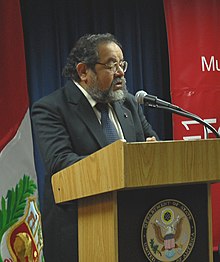Walter Alva
Walter Alva | |
|---|---|
 Alva in 2011 | |
| Born | Walter Alva Alva 28 June 1951 Contumazá Province, Peru |
| Occupation | Archaeologist |
| Employer | Bruning Archeological Museum |
| Known for | Discovery of the Lord of Sipan's tomb |
| Awards | Orden El Sol del Peru |
Walter Alva (born 28 June 1951), born Walter Alva Alva, is a Peruvian archaeologist specializing in the study and excavation of the prehistoric Moche culture. He is known for two major finds: the tomb of the Lord of Sipan and related people in 1987, and 2007.
Early life and education
[edit]Alva was born on 28 June 1951 in Contumazá Province.[1] He earned his undergraduate and graduate degrees in archaeology.
Career
[edit]Alva has worked for years at the Bruning Archeological Museum in Lambayeque, Peru. He advanced to the post of director there.
Major finds
[edit]Lord of Sipan
[edit]In 1987, Alva was called by police to investigate a site at Sipán, where huaqueros (grave robbers) had stolen artifacts from an archaeological site. Despite being ill with bronchitis, he made the trip. The robbers had discovered a crypt of a lord, filled with jewels and gold, and Alva knew it was significant.[2] Alva did most of the excavating without delay, as he was concerned that robbers might come back and cause more damage. As a result, he started digging without any funding or the support of the area police, with matters made worse as the result of the primary robber being killed by police.[2]
After further digging, Alva found, among other things, the undamaged body of a Moche lord.[3] From these finds, he and other scholars were able to determine that Huaca Rajada, a group of three pyramids once thought to belong to the later Chimú culture, were a part of Moche culture.[3] The findings were later described by the National Geographic Society as the richest intact pre-Columbian tomb in the Western Hemisphere.[4]
During many of these years, Alva was the director of the Bruning Archaeological Museum in Lambayeque, Peru.
Murals at Ventarron
[edit]In 2007, Alva discovered murals at a 4,000-year-old Peruvian temple in Ventarron. The murals, showing a deer caught in a net, are considered the oldest murals in the Americas.[3] Alva determined their age by the process of carbon dating.[5] The construction material that was used at the temple was not primitive.[6] As a result, Alva was able to show that the civilization was able to spread farther than originally thought.[3] He worked on the dig with his son Ignacio, who is also an archaeologist.[7]
Legacy and honors
[edit]- 1990, the Orden El Sol del Peru was awarded to Alva.[1]
- 2015, Alva won the Esteban Campodónico Prize in the area of outstanding professional activity in service to Peruvian society.[8]
References
[edit]- ^ a b Jorge Pereyra Terrones (2009). 101 Razones por las que estoy orgulloso de ser cajamarquino (in Spanish). Cajamarca: Universidad Antonio Guillermo Urrelo. p. 87.
- ^ a b "Raiders of the Lost Tomb". UnMuseum. Retrieved 2010-02-09.
- ^ a b c d "Walter Alva". Minnesota State University, Mankato. Archived from the original on 2010-05-28. Retrieved 2010-02-09.
- ^ Gomer, Peter (September 14, 1988). "Gold-filled tomb casts light on ancient culture". Chicago Tribune. p. 1.
- ^ Heam, Kelly (November 12, 2007). "Oldest Temple, Mural in the Americas Found in Peru". National Geographic. Archived from the original on November 14, 2007. Retrieved 2010-02-09.
- ^ "Ancient Peruvian Temple Hints at Lost Civilization". FOX News. November 13, 2007. Retrieved 2010-02-09.
- ^ "Archaeologists find pre-Columbian tomb". NBC News. July 7, 2008. Retrieved February 19, 2009.
- ^ "2015 Dr Walter Alva Alva (in Spanish)". Premio Campodonico. Universidad de Piura. Retrieved 14 October 2024.
